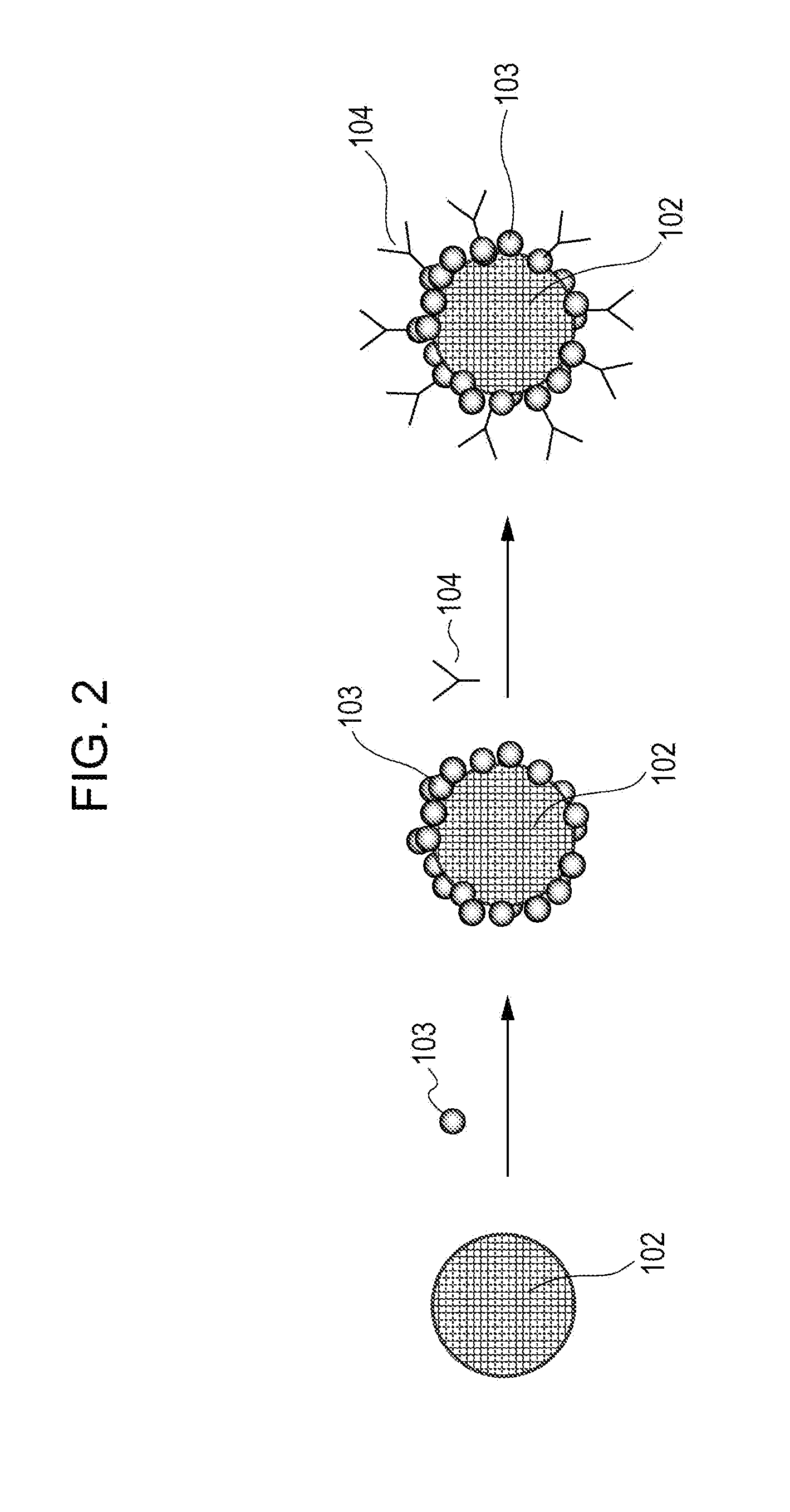Composite particle, contrast agent for photoacoustic imaging, and photoacoustic imaging method
a contrast agent and photoacoustic imaging technology, applied in the field of composite particle, can solve the problems of inability to bound antibodies and fluorochromes in large numbers, small acoustic wave emitted by resovist (registered trademark), and difficult to detect specific antigens
- Summary
- Abstract
- Description
- Claims
- Application Information
AI Technical Summary
Benefits of technology
Problems solved by technology
Method used
Image
Examples
first embodiment
[0018]A composite particle according to the present embodiment includes a particle (hereafter may be referred to as a core particle) containing a first dye having a molar absorption coefficient of 10 M−1cm−1 or more at least one wavelength selected within the range of 600 nm to 1,300 nm, a second dye which is bound to the surface of the above described particle and which has a molar absorption coefficient of 10 M−1cm−1 or more at least one wavelength selected within the range of 600 nm to 1,300 nm, and an antibody, wherein the above described antibody is bound to the above described second dye.
[0019]The composite particle according to the present embodiment includes the second dye in addition to the first dye. Therefore, light is absorbed to a great extent, and a large acoustic wave can be emitted. Meanwhile, the antibody can be bound to a part of or all the second dye bound to the particle 102. In the case where the second dye has a plurality of binding site, to which the antibody ...
second embodiment
[0100]A composite particle according to a second embodiment of the present invention will be described with reference to FIG. 1. Regarding the individual constituents of the composite particle according to the present embodiment, explanations of those described in the first embodiment will not be provided here.
[0101]The composite particle 101 according to the present embodiment is formed from a particle 102 containing an inorganic material, organic dyes 103 bound to the above described particle, and antibodies 104. Then, it is a feature that the antibody 104 is bound to the organic dye 103.
[0102]As described above, the organic dye 103 is bound to a binding site, to which the organic dye can be bound, of the particle containing iron oxide. The antibody 104 may be bound to a part of or the whole organic dye 103 bound to the particle 102. In the case where the organic dye 103 has a plurality of binding sites, to which the antibody 104 can be bound, a plurality of antibodies 104 may be ...
synthesis example 1
[0118]Binding Between Polyfunctional Dye and Particle Including Iron Oxide Particle (1)
[0119]As for the organic dye, Cy 5.5 bisfunctional reactive dye (produced by GE Healthcare) (hereafter may be referred to as Dye A) serving as a polyfunctional dye represented by Formula (5) described above was used. A reaction between nanomag (registered trademark)-D-spio (produced by Micromod, average particle diameter 50 nm) (hereafter may be referred to as NP), which is a particle including the iron oxide particle and having Dye A and an amino group on the surface, and Cy 5.5 was effected at room temperature for 1 hour. The reaction solvent was a carbonate buffer and the pH was specified to be 8. The reaction molar ratio (fed Dye A / particle including iron oxide particle) was specified to be 0, 1,600, or 8,330. Here, the term “fed” refers to “added to a reaction system” and the term “reaction molar ratio” refers to “ratio of the molarity of Dye A added to the reaction system to the molarity of ...
PUM
| Property | Measurement | Unit |
|---|---|---|
| Nanoscale particle size | aaaaa | aaaaa |
| Nanoscale particle size | aaaaa | aaaaa |
| Wavelength | aaaaa | aaaaa |
Abstract
Description
Claims
Application Information
 Login to View More
Login to View More - R&D
- Intellectual Property
- Life Sciences
- Materials
- Tech Scout
- Unparalleled Data Quality
- Higher Quality Content
- 60% Fewer Hallucinations
Browse by: Latest US Patents, China's latest patents, Technical Efficacy Thesaurus, Application Domain, Technology Topic, Popular Technical Reports.
© 2025 PatSnap. All rights reserved.Legal|Privacy policy|Modern Slavery Act Transparency Statement|Sitemap|About US| Contact US: help@patsnap.com



